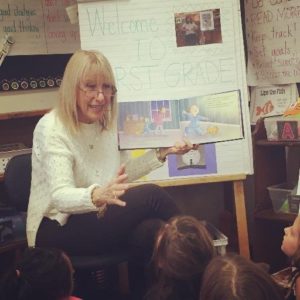 The final Author Interview of 2019 is with … Carol Gordon Ekster. Here are nine biographical bullet points to help you get to know her a bit better.
The final Author Interview of 2019 is with … Carol Gordon Ekster. Here are nine biographical bullet points to help you get to know her a bit better.
- Elementary school teacher for 35 years.
- Does yoga daily.
- As an adult, finally learned she loves dogs!
- Used to live in Brooklyn, right near the boardwalk and beach.
- Graduated from Boston University.
- Has a Master’s degree in reading and language.
- Married Mark, a high school pal.
- Has a daughter, Dara, who “continues to fascinate me and teach me new things all the time.”
- Belongs to five picture book critique groups.
With that, it’s time to interview away. Here we go!
- Website: www.carolgordonekster.com
- Twitter: @cekster
- Goodreads: www.goodreads.com/author/show/1867583.Carol_Gordon_Ekster
RVC: Let’s start with a different question than I normally ask in these interviews. You’re more prolific on social media than many writers I encounter—witness 39k thousand tweets, for example! What’s your social media strategy? (And your secret for success, too, if you don’t mind sharing!)
CGE: Thanks for noticing, Ryan! I work hard to keep active on Twitter. I promote other #kidlit authors whenever I can. I share #amwriting content that I think is valuable. You don’t want to just promote your own books. That’s not how it works. But Twitter is my favorite social media platform for authors. When I can, I follow #PBchat nights. I learn from the agents, editors, and other authors and illustrators who are in the trenches of this children’s literature world. It’s all so interesting and informative. I keep up with others getting contracts, new books coming out, incredible resources and opportunities, etc. And I’ve done #PBpitch. It’s how I sold my fifth book. Last October when I participated, an editor liked my pitch, I sent in my manuscript and was offered a contract. You can read about my #PBpitch success here: http://www.pbpitch.com/book-dealssuccess-stories.html
Twitter is also a fun way to connect with readers and educators. As a retired teacher, I love connecting with educators who share a passion for books and use them consistently with their students. I also follow @nerdybookclub and nerdcamps (like @nErDcampVT and @nErDcampLI) on Twitter.
I limit my time on any social media as I don’t want to take too much time away from actual writing, but this is absolutely an important aspect of writing. It helps you build your platform, which is imperative if you want to get your name and books out there. Don’t forget though, I’m retired from teaching with no little ones around, so I have the time and opportunity to devote to my writing life.
RVC: How specifically did your years of teaching prepare you for this terrific second career?
CGE: Well, not only was my master’s degree in reading and language, but it seems that all the workshops and courses for recertification all throughout my career dealt with either writing or picture books. Though I never wanted to write myself (at the time), I did feel having writing workshops for my fourth graders was imperative to their education and growth as individuals. We didn’t write fiction. They wrote about what they knew. Each child left my class with a book of their writing from the year…something I know families cherished. Reading so many picture books throughout the year to support all aspects of my curriculum as well as social issues that arose, as well as helping children write, prepared me for becoming a children’s author.
When I started writing at the end of my career and sharing my work with students, it was a fantastic experience for them to see me go through the writing process. I loved hearing their feedback and I think it was invaluable for them to see how I worked to improve my writing through revision. My background also helps me create follow-up activities for my books as well as know how to interact with children in readings or school visits.
RVC: Your picture book career seemed to have officially begun on a beach in the summer of 2002. Talk about what happened, and what the process was in terms of moving from an idea to publication with that first book.
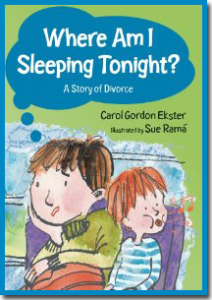 CGE: I took lots of courses and workshops on writing, but I never wanted to write. I found writing challenging. Then a few years before retiring, it’s like the universe aligned for me to have another career. I’m absolutely not the sitting around type, so this was a gift. Out of the clear blue, I walked off the beach on this particular day, went to get Post-its and a pen from my car, and wrote my first picture book that day. It seriously felt like I had no control in this action. Writing happened to me. I never looked back and dug into the writing life. That first manuscript was didactic, too long, read more like a magazine article, and would never sell. I joined SCBWI and a critique group, and the stories kept coming. The 20th manuscript I wrote, Where Am I Sleeping Tonight?, was the first one to sell. Six years after that day on the beach, I held my first published book in my hand.
CGE: I took lots of courses and workshops on writing, but I never wanted to write. I found writing challenging. Then a few years before retiring, it’s like the universe aligned for me to have another career. I’m absolutely not the sitting around type, so this was a gift. Out of the clear blue, I walked off the beach on this particular day, went to get Post-its and a pen from my car, and wrote my first picture book that day. It seriously felt like I had no control in this action. Writing happened to me. I never looked back and dug into the writing life. That first manuscript was didactic, too long, read more like a magazine article, and would never sell. I joined SCBWI and a critique group, and the stories kept coming. The 20th manuscript I wrote, Where Am I Sleeping Tonight?, was the first one to sell. Six years after that day on the beach, I held my first published book in my hand.
RVC: Listed among the bio tidbits above is the fact that you’re in five critique groups. How does that work for you? Do you run the same manuscript by each group?
CGE: I started in one group, but then so many people joined as we met in a public library. This meant that we had to open it to the public. I could no longer share my work every time we met. I started writing later in life, so I think that’s why I write so much, making up for lost time. I had so many manuscripts to share that I began to seek out other groups. I keep a spreadsheet of the manuscripts I bring to each group, and sometimes I do bring the same one to different groups, but I’m not consistent about that. I simply have too many stories!
RVC: You’re a long-time member of SCBWI. What’s the #1 most useful thing that organization did for you? Why should aspiring picture book writers consider joining?
CGE: I honestly wouldn’t be published without SCBWI. My first two manuscripts were bought in response to my submitting to publishers who listed a call for submissions in the Bulletin. In addition, the professional support, conferences, resources, and opportunities for submission to editors, have helped me with my craft and my career. Aspiring picture book writers need to join SCBWI if they’re serious about this business. It’s essential.
RVC: From what I’ve read about you in other interviews, it sounds as if you’re playing a pretty big game in terms of submissions. What’s the ratio of how many books you’ve sold vs. how many manuscripts you’ve submitted? How do you keep the energy up? The organization/record-keeping?
CGE: Yes. I do submit quite a bit. Let’s just say at this point, I’ve collected close to 2,000 rejections from agents and publishers. If you want to do the math, I’ve sold five books, two magazine articles, and one e‑book. I used to have a paper sheet for each manuscript, but that became burdensome as I approached 100 manuscripts. I recently transferred that information to a Google document, which is much easier. I keep my energy up by believing in the process. For my newest acquisition, Some Daddies, which will be out in 2021, I saw the difference in what an agent previously said (“I like it. There aren’t enough daddy books”) to the response I got from the acquiring editor: “We love how this book celebrates the diversity of what it can look like to be a dad. This is so important for young kids who are starting to notice other children’s parents and compare them to their own, as well as how they develop their perception of healthy masculinity. This is a joyful book with a serious message—the type of book we would be proud to publish at Beaming Books.”
That’s what you want, an editor to love your manuscript. That’s what you’re waiting for.
RVC: What happens when you get a rejection? Do you have a standard response strategy?
CGE: I move on and think about where to send it next! I have to believe it’s just not the right publisher or agent.
(Okay, I feel a little badly, especially when I first send something out and have hope in my heart…but I get over it.)
RVC: While you’ve claimed that you don’t LOVE book promoting, you sure seem committed to doing a lot of it. What’s a book PR success story in your past?
CGE: I don’t love promoting, because it can be uncomfortable. I like the creative aspects, like thinking about who will be interested in knowing about this book. I enjoy offering advice to my writing buddies about where they might sell their books. I’m not sure how successful I’ve been, but I know that for my book on shared custody, I reached out to many divorce lawyers in my state who had resources on their website. And I recently noticed a five-star review on Amazon that said, “I am a divorce attorney. I give this book out to clients who have children going through this. It is a great way for parents and children to have healthy conversations about their situation.”
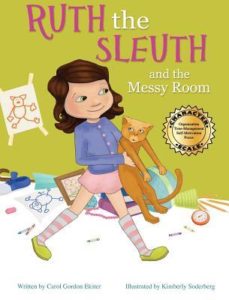 In the past, I’ve had fun thinking outside the box. I contacted a few bakeries to sell Ruth the Sleuth and The Messy Room. The story begins and ends with chocolate chip cookies. Two bakeries took books on consignment. One owner told me many people read the book, but only a few buy it. I didn’t sell a lot of books. Sometimes it’s not about sales. I believe that you never know where one reading of a book may lead.
In the past, I’ve had fun thinking outside the box. I contacted a few bakeries to sell Ruth the Sleuth and The Messy Room. The story begins and ends with chocolate chip cookies. Two bakeries took books on consignment. One owner told me many people read the book, but only a few buy it. I didn’t sell a lot of books. Sometimes it’s not about sales. I believe that you never know where one reading of a book may lead.
RVC: What’s the most important thing people should know or understand about being a traditionally published picture book author?
CGE: You’ll need patience, perseverance, and dedication. And you have to learn to accept this path with all its twists, turns, disappointments, expectations and joys. It’s not an easy path, but it IS an amazing journey. Learn to feel gratitude for being able to touch lives in this way and remember to enjoy the ride!
RVC: How do you keep a picture book from being too didactic, yet still have lessons in it? I’m especially thinking about Where Am I Sleeping Tonight? here.
CGE: Oh, goodness. I’m still a teacher at heart. A lot of my stories are too didactic. But I’m working on it. Where Am I Sleeping Tonight? (A Story of Divorce) is a bit lesson heavy (I deal with responsibility in this book as well as divorce), but it’s also heartfelt and helps children through this emotional and difficult situation. I know it makes them feel less alone.
RVC: Without giving away too much, what are you working on now?
CGE: I always work on a few things at once…and tackle whatever I’m moved to work on. It’s so wonderfully opposite my teaching life. No daily schedule. No ringing bells. I decide when and what I want to work on, which is mostly a mix of fiction stories, concept books, and some biographies. There are 27 items in my “still revising” folder and another document with many ideas that I haven’t really developed yet. There…I didn’t give anything away!
RVC: Fair enough! It’s time to transition to THE LIGHTNING ROUND. Cheetah-fast questions and race-car-quick answers, please! Ready?
CGE: Ready!
RVC: Favorite place to get a gift card for?
CGE: Starbucks or a bookstore.
RVC: Best delivery system for chocolate?
CGE: This will sound weird but I get it in my calcium…it’s dark chocolate, looks like candy, and is delicious!
RVC: What’s your secret talent?
CGE: Ooh…I wish I had one!
RVC: If your books were children, which one are you most proud of?
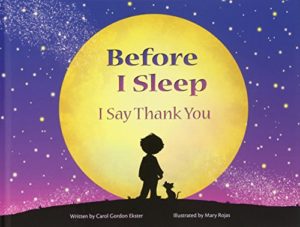 CGE: As long as the others didn’t find out…I’ll whisper to you that it’s probably Before I Sleep: I Say Thank You, because I believe teaching children gratitude can make for a happier society. And it went into its third printing in the first two years. (But I do have reasons why I love each one of my books. And now I feel guilty. You’re a very tough-question-askerer!)
CGE: As long as the others didn’t find out…I’ll whisper to you that it’s probably Before I Sleep: I Say Thank You, because I believe teaching children gratitude can make for a happier society. And it went into its third printing in the first two years. (But I do have reasons why I love each one of my books. And now I feel guilty. You’re a very tough-question-askerer!)
RVC: An under-appreciated but awesome picture book of the past year?
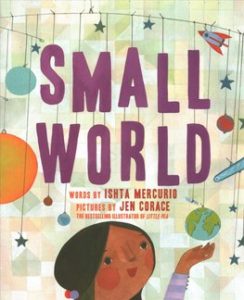 CGE: It’s so hard to pick just one. I read so many picture books every week. But I loved a recent book that I read. It’s beautifully written and a touching book: Small World by Ishta Mercurio, illustrated by Jen Corace.
CGE: It’s so hard to pick just one. I read so many picture books every week. But I loved a recent book that I read. It’s beautifully written and a touching book: Small World by Ishta Mercurio, illustrated by Jen Corace.
RVC: Best compliment a student ever gave you?
CGE: A compliment that I always appreciated hearing was, “You make learning fun,” because I worked really hard to ensure students experienced the joy of learning.
RVC: Thanks so much, Carol!


Awesome interview with one of my favorite writers!
Phaea, thanks for reading this and for being such a supportive #kidlit #amwriting buddy. So glad we connect at the NESCBWI conference a few years ago. Grateful we are traveling this journey together.